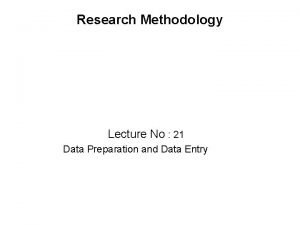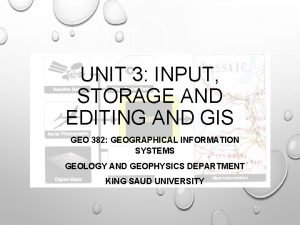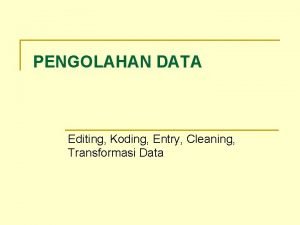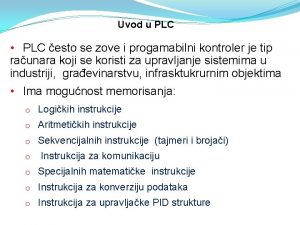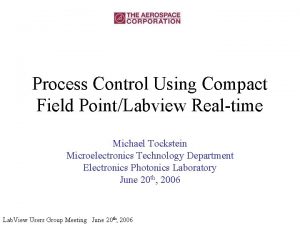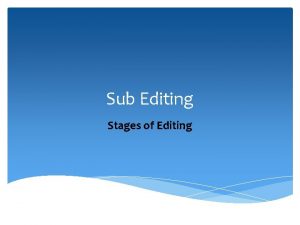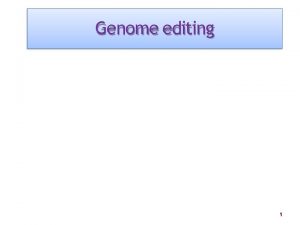UNIT 3 MODULE 5 Data Input Editing INTRODUCTION










- Slides: 10

UNIT 3 – MODULE 5: Data Input & Editing

INTRODUCTION • Putting data into a computer (called data coding) is a fundamental process for virtually all GIS projects. • Recall that spatial data: – Is acquired from various sources. – Has different formats. – Can be captured (inputted) with several methods. • Once data is contained within a GIS, nearly all data must be corrected/manipulated to fit the model chosen for data access.

ANALOG VS DIGITAL DATA • Analog – non-electronic data. Must be converted digitally prior to using in a GIS. • Examples: printed aerial photographs, paper maps. • Digital – data in a format that computers can use. • Examples: satellite imagery, GPS data. Credit: NASA

DATA INPUT METHODS • There are several ways to turn analog data into digital data: – Keyboard Entry – Entering data (into a file) by way of a computer terminal. • Example: entering names from a sign-in sheet. – Manual Digitizing – Requires a digitizing table connected to a computer station. • Example: digitizing mountain tops from an aerial photo. – Automatic Digitizing – Scanning is the most common. • Example: scanning an old map or photo into digital format.

SCANNING • When scanning analog data, several problems can arise: – Optical Distortions – Unwanted Data/Info (e. g. Coffee Stains, Hand-Written Annotations) – Non-Uniform Scanning Between Front & Background Data – File Format Non-Compatible with GIS – Time Required for Producing Compatible Data for Analysis Credit: Epson Credit: www. gifmania. us

ELECTRONIC DATA TRANSFER • Data input methods can create difficulties, which takes more time to address. • It is ideal to use data that is already in a digital format. Then it’s a question of format type. • If a format type is already compatible with a GIS, then it’s simply a matter of transferring data, but that will not likely be the case. • Data transfer often followed by converting data into a usable GIS format type.

DATA EDITING • Problems can arise during data encoding. • Data is seldom error-free upon transfer into a GIS. • Errors could exist from the source data, generated during data transfer or during the data encoding process. • Better to detect & correct errors during this process than integrating into a GIS and then addressing errors.

DETECTING & CORRECTING ERRORS – Attribute Data • Attribute data errors are simple to identify. • Methods available for checking errors: – Impossible Values – viable when range of data is known. Example: negative rainfall measurements. – Extreme Values – cross-check against source data. Example: a hotel with 50, 000 rooms is clearly wrong. – Internal Consistency – GIS attribute data totals should match source document data. – Scattergrams – a type of graphing that can identify errors if two or more attribute data variables are linked. Example: altitude & temperature.

DETECTING & CORRECTING ERRORS – Spatial Data • Spatial data errors more difficult to identify & correct. • Common spatial data errors include: – Missing Entities – points, lines or boundary segments (PLBS) are missing. – Duplicate Entities – PLBS digitized twice or more times. – Mislocated Entities – PLBS digitized in the wrong place. – Missing Labels – polygons are unidentified. – Duplicate Labels – a polygon has more than one identification label.

GEOCODING • Converting an address into a coordinate for a map. • Addresses are an important part of various data sets. • Most GIS software products are able to geocode addresses. • Geocoding is impacted by data quality. • Inconsistencies can exist in address data, such as using “Street” instead of “Avenue. ”
 Field editing and central editing in research
Field editing and central editing in research Nonlinear video editing
Nonlinear video editing Spatial data editing in gis
Spatial data editing in gis Pengolahan data editing coding processing cleaning
Pengolahan data editing coding processing cleaning C device module module 1
C device module module 1 Uvod
Uvod Input output module in computer architecture
Input output module in computer architecture Digital input module for compact fieldpoint
Digital input module for compact fieldpoint Pengertian peripheral input
Pengertian peripheral input Finely tuned input and roughly tuned input
Finely tuned input and roughly tuned input Unit 10, unit 10 review tests, unit 10 general test
Unit 10, unit 10 review tests, unit 10 general test
